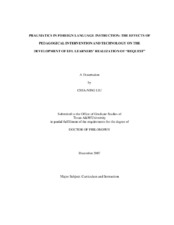| dc.contributor.advisor | Cifuentes, Lauren | |
| dc.contributor.advisor | Eslami, Zohreh | |
| dc.creator | Liu, Chianing | |
| dc.date.accessioned | 2010-01-15T00:06:08Z | |
| dc.date.accessioned | 2010-01-16T00:36:29Z | |
| dc.date.available | 2010-01-15T00:06:08Z | |
| dc.date.available | 2010-01-16T00:36:29Z | |
| dc.date.created | 2007-12 | |
| dc.date.issued | 2009-05-15 | |
| dc.identifier.uri | https://hdl.handle.net/1969.1/ETD-TAMU-2490 | |
| dc.description.abstract | This study investigated the effectiveness of explicit pragmatic instruction on the
acquisition of requests by college-level English as a Foreign Language (EFL) learners in
Taiwan. The researcher applied quantitative and qualitative approaches to determine first
whether the use of explicit pragmatic instruction had a positive effect on EFL learners’
pragmatic competence. Second, the relative effectiveness of presenting pragmatics
through two delivery systems—face-to-face, in-class activities and computer-mediated
communication (CMC) via e-mail and WebCT—was compared.
One hundred and eighteen Taiwanese undergraduate students who made up three
intact classes in an “English for Tourism” course completed the entire study. The three
groups were: (1) the control group, in which students received no explicit instruction on
pragmatics but received instructor-led lessons from the textbook’s teacher’s manual, (2)
the experimental/Teacher Instruction (TI) group, in which students learned pragmatics in
a face-to-face classroom setting with explicit instruction on pragmatics, and (3) the
experimental/CMC group, in which students learned pragmatics explicitly through e-mail
and WebCT discussions with their partners at Texas A&M University. There were 40 Taiwanese students in the control group, 36 Taiwanese students in the
experimental/Teacher Instruction group and 42 Taiwanese students in the
experimental/CMC group. Treatment types (Control/TI/CMC) were randomly assigned to
the intact classes.
The results showed that explicit pragmatic instruction had a positive impact on the
EFL learners in both the Teacher Instruction and CMC groups. Learners who received
explicit pragmatic instruction performed better on the Discourse Completion Task
posttest than those who did not. The findings also indicated that technology can be a
valuable tool for delivering pragmatics instruction. | en |
| dc.format.medium | electronic | en |
| dc.format.mimetype | application/pdf | |
| dc.language.iso | en_US | |
| dc.subject | Pragmatics | en |
| dc.subject | Instruction | en |
| dc.subject | Technology | en |
| dc.subject | EFL | en |
| dc.title | Pragmatics in foreign language instruction: the effects of pedagogical intervention and technology on the development of EFL learners' realization of "request" | en |
| dc.type | Book | en |
| dc.type | Thesis | en |
| thesis.degree.department | Teaching, Learning, and Culture | en |
| thesis.degree.discipline | Curriculum and Instruction | en |
| thesis.degree.grantor | Texas A&M University | en |
| thesis.degree.name | Doctor of Philosophy | en |
| thesis.degree.level | Doctoral | en |
| dc.contributor.committeeMember | Burlbaw, Lynn | |
| dc.contributor.committeeMember | Hall, Robert | |
| dc.type.genre | Electronic Dissertation | en |
| dc.type.material | text | en |
| dc.format.digitalOrigin | born digital | en |


